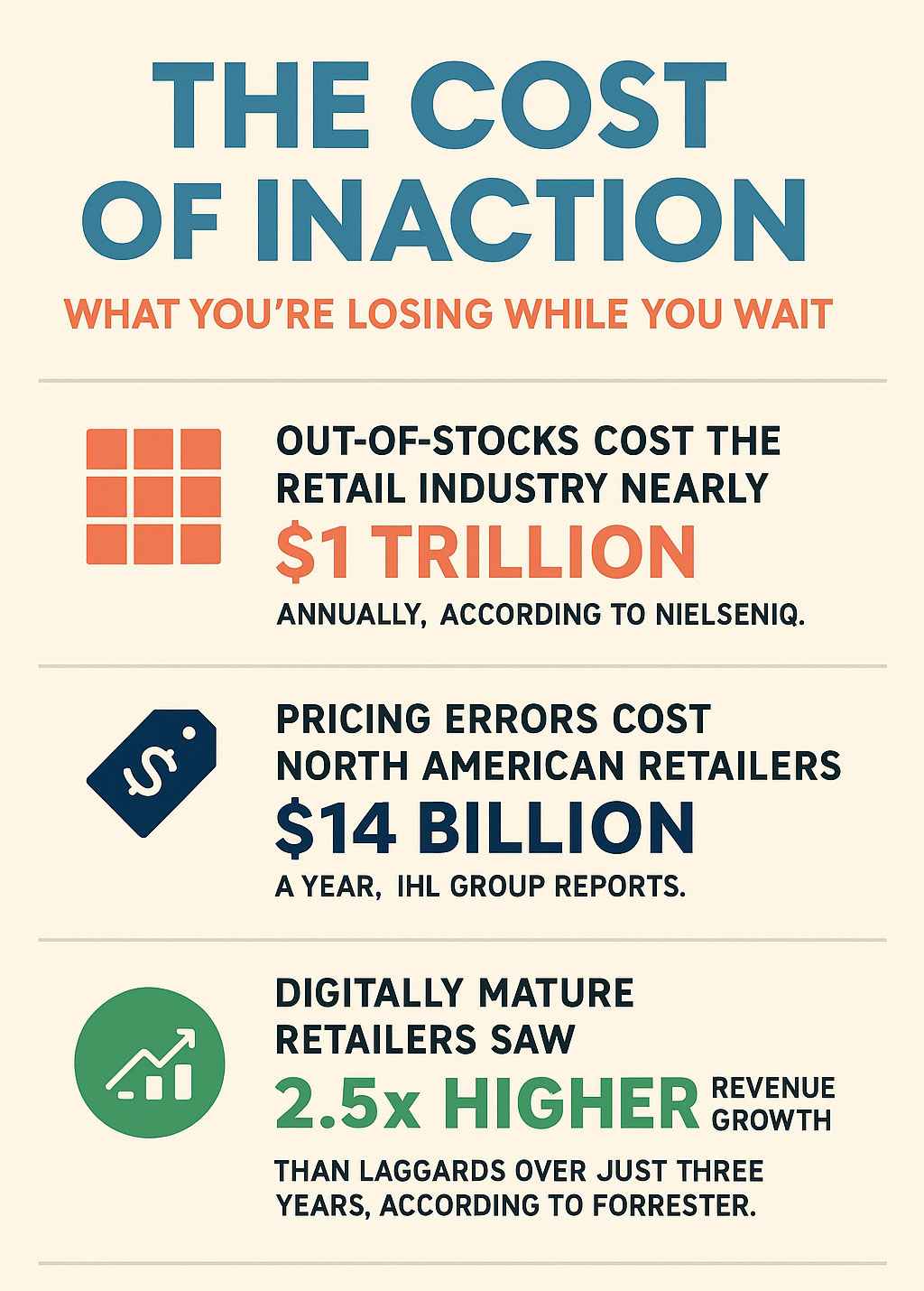The High Cost of Waiting: Why Delaying Automation Is the Riskiest Move in Retail


The Paradox of “Waiting for the Right Time”
In retail, timing is everything—especially when it comes to investment. But too often, the decision to delay feels safer than the decision to act. Across conversations with leaders at every tier of the industry, one pattern consistently emerges: most agree that automation and digital transformation are necessary—but many remain stuck in “wait and see” mode.
- Maybe they’re waiting for the next budget cycle.
- Or for technology to mature just a little more.
- Or for staffing challenges to ease up.
But here’s the reality: retail doesn’t wait. Shopper expectations, labor pressures, and competitive benchmarks keep accelerating.
Meanwhile, others are already acting. Retailers that move now are not just gaining efficiency—they’re setting the standard your shoppers will compare you to.
Standing still isn’t the safe move—it’s the one that gets you left behind
Retail Has Changed. Expectations Haven’t Slowed Down.
Retailers today are being asked to do more—with less.


- According to McKinsey’s 2024 State of Grocery Report, 63% of consumers say they’ve switched retailers due to poor shelf availability or pricing accuracy.
- Deloitte’s 2024 Retail Outlook shows that labor availability remains 20–30% below pre-pandemic levels.
- And leading operators are already embracing automation, AI, and real-time analytics—raising performance benchmarks across the board.
Shoppers don’t adjust their expectations based on your internal constraints. They simply compare experiences—and vote with their feet (or phones). If your store is manually chasing inventory issues while others resolve them in near-real time, you’re no longer competing on level ground. Execution is now the differentiator.
And every delay gives your competitors a head start.
The Cost of Inaction: What You’re Losing While You Wait
The decision not to invest may feel like you’re avoiding risk. But it’s often the fastest way to incur hidden costs.
- Out-of-stocks cost the retail industry nearly $1 trillion annually, according to NielsenIQ.
- Pricing errors cost North American retailers over $14 billion a year, IHL Group reports.
- Forrester found that digitally mature retailers saw 2.5x higher revenue growth than laggards over just three years.
These aren’t future risks. They’re happening right now—among teams doing things the “old way.”
Retailers delaying automation risk:
- Eroded loyalty from shoppers who experience preventable service failures
- Lost margin through inefficient store execution
- Higher turnover from teams stretched too thin
- Falling further behind competitors who are already scaling smarter
The longer you wait, the further the gap grows.
Today’s Automation Is Designed to Be Practical—Not Disruptive
Old assumptions are hard to shake. Many still believe automation means months of integration, capital outlay, and complex change management.
But that’s no longer true. Modern automation solutions are built for rapid deployment as managed services—eliminating upfront investment and reducing ongoing technical debt.
- No large capital outlay
- No fear of obsolescence
- No disruption to existing systems or workflows
These are tools built to move at retail speed, enabling smarter execution without slowing down your team. The question is no longer, “Is it possible?”
It’s how much longer can you afford not to?
The Illusion of “Doing Fine”
Perhaps the biggest threat to progress is the idea that everything’s “fine.” But “fine” often hides costly friction points:
- Gaps that never get seen
- Errors that quietly erode trust
- Associates too stretched to meet standards
- Revenue slowly leaking through cracks in execution
A high-velocity item out of stock for four hours in one store might seem small—until you multiply that across locations, weeks, and shopper expectations. According to Bain & Company’s 2024 study, retailers with strong execution outperform their peers in loyalty and trip frequency by 2x.
Are you building momentum—or falling behind while feeling comfortable?
Where to Begin—Before the Gap Grows Wider
You don’t need to automate everything at once. But you do need to start.
Retailers seeing the biggest gains began with:
- Out-of-stock detection in high-velocity aisles
- Price verification tied to ad breaks
- Planogram audits in seasonal sets
- Hazard monitoring during high-risk hours
They didn’t wait for perfect timing. They looked for early wins—and built from there.
Each delay is a missed opportunity to learn, adapt, and improve.
And every competitor who starts first gets there faster.
The Retailers Who Wait Will Watch Others Win
In today’s environment, transformation isn’t about chasing trends. It’s about survival and separation.
Retailers who keep delaying automation aren’t avoiding risk—they’re absorbing it. Every week of inaction is another step behind those who are already improving pricing accuracy, replenishment speed, and associate focus.
The gap is real.
The clock is running.
And shoppers are noticing.
There’s no perfect time. But there is a perfect window: before your competitors outdistance you completely.
Final Thought
Falling behind happens gradually—then suddenly.
Don’t let “wait and see” become “too little, too late.”